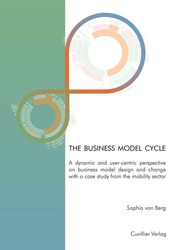| Departments | |
|---|---|
| Book Series (96) |
1379
|
| Nachhaltigkeit |
3
|
| Gesundheitswesen |
1
|
| Humanities |
2367
|
| Medienwissenschaften | 16 |
| Theology | 57 |
| Philosophy | 102 |
| Law | 422 |
| Economics | 851 |
| Social sciences | 416 |
| Sports science | 48 |
| Psychology | 233 |
| Educational science | 190 |
| History | 183 |
| Art | 111 |
| Cultural studies | 166 |
| Literary studies | 117 |
| Linguistics | 88 |
| Natural Sciences |
5407
|
| Engineering |
1793
|
| Common |
98
|
|
Leitlinien Unfallchirurgie
5. Auflage bestellen |
|
Advanced Search
The business model cycle (English shop)
A dynamic and user-centric perspective on business model design and change
Sophia von Berg (Author)Preview
Extract, PDF (270 KB)
Table of Contents, PDF (140 KB)
Today, firms all over the world have to deal with dynamic business environments. Fast-moving digitalization has made information more transparent, strengthening the role of the customer. At the same time, the provider can have a much closer relationship with the user, thanks to real-time communication. However, corporate practice does not have a process for developing dynamic business models, and user-centric business models that can be designed and changed using smart technologies have not yet been systematically integrated. To stay competitive, companies need to rise to this challenge. The aim of this dissertation was to develop a dynamic, user-centric process model for business model design and change, and to evaluate the model’s ability to maintain a competitive advantage in the mobility sector. First, the differences between static, dynamic, and user-centric business models and their corresponding attributes were deduced. Then, these findings were combined into a process model using system dynamics logic. This model considers the user a co-creator of value and helps managers react to real-time changes in their business model environment. Finally, a mobility sector case study is presented to highlight the relevance of this model to real-world application. This business model cycle (BMC) supports the strategic management of dynamic, user-centric business model design and change activities. It describes a step by step procedure of business model design that includes ideation, prototyping, and integration of business model options. Moreover, it allows continuous monitoring of the business model environment and adaption of the model accordingly. At the same time, bidirectional interaction between the user and provider is possible, allowing the provider to adapt to their users’ needs. The BMC is unique in that these processes can take place simultaneously. Finally, the real-world case study in the mobility sector confirmed that using the BMC for strategic management maintains a lasting competitive business advantage.
| ISBN-13 (Hard Copy) | 9783736973329 |
| ISBN-13 (eBook) | 9783736963320 |
| Final Book Format | B5 |
| Language | English |
| Page Number | 282 |
| Lamination of Cover | glossy |
| Edition | 1 |
| Publication Place | Göttingen |
| Publication Date | 2020-12-17 |
| General Categorization | Dissertation |
| Departments |
Economics
Business economics |
| Keywords | provider integration, Anbieterintegration, user-centric market segmentation, Nutzerzentrierte Marktsegmentierung, benefit segmentation, Nutzensegmentierung, Behavioral customer model, Verhaltensorientiertes Kundenmodell, customer, Kunde, user, Nutzer, competitive advantage, Wettbewerbsvorteil, Point of Use , PoU, digitalization, Digitalisierung, real-time data, Echtzeitdaten, user data, Nutzerdaten, data analytics, Data Analytics, big data, Big Data, ambient intelligence, Ambient Intelligence, Umgebungsintelligenz, Internet of Things, Internet of Things, Internet der Dinge, Artificial Intelligence, Künstliche Intelligenz, self-learning algorithm, selbstlernender Algorithmus, network theory, Netzwerktheorie, business networks, Unternehmensnetzwerke, solution networks, Lösungsnetzwerke, value networks, Wertschöpfungsnetzwerke, value-creating concepts, Wertgenerierende Konzepte, systems theory, Systemtheorie, system dynamics, Systemdynamik, dynamic systems, Dynamische Systeme, feedback model, Feedback-Modell, process model, Prozessmodell, Vorgehensmodell,BPMN, Business Process Model and Notation, case study, Fallstudie, Software as a Service, SaaS, transportation, Transport, mobility, Mobilität, ridepooling, Mitfahrgelegenheit, multi-modal mobility, Multimodale Mobilität, new mobility, Neue Mobilität, connected mobility, Vernetzte Mobilität, Strategic Management, Strategisches Management, General Management, Marketing, wertgenerierend, Wettbewerb, competition |








